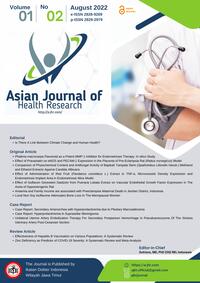Case Report: Secondary Amenorrhea with Hyperprolactinemia due to Pituitary Macroadenoma
Keywords:
Keywords: hyperprolactinemia; pituitary macroadenoma; dopamine agonistAbstract
Introduction: Secondary amenorrhea has a broad etiology, so each case must be studied in depth. One of the causes of secondary amenorrhea is a state of hyperprolactinemia caused by a mass in the anterior pituitary. Pituitary macroadenoma patients may be asymptomatic or have a hormone imbalance or mass impact symptoms. Tumors in asymptomatic patients might be identified during a routine head imaging examination for unrelated medical issues.
Case Presentation: A 24-year-old unmarried woman with complaints of headache, blurred vision, and worsening for one year ago. The patient complained of not having menstruation in the past five years ago, with a history of previous normal menstruation. On physical examination, found breast and pubic Tanner stage 5. On laboratory examination, it was found FSH (2.21), Oestradiol (20.23), and Prolactin (1365.47). On an MRI of the head examination on April 14, 2021, a solid intrasellar mass of suspected pituitary macroadenoma was found with a size of ± 1.3 cm x 1.4 cm x 1.6 cm.
Conclusion: Secondary amenorrhea caused by hyperprolactinemia due to pituitary macroadenoma is a rare case (40%). First-line therapy for prolactinomas is dopamine agonist administration because most pituitary macroadenomas respond to dopamine agonists.
Downloads
Published
Issue
Section
License
Copyright (c) 2022 Annissa Febriani, Donny Wisnu Wardhana, Nugrahanti Prasetyorini, Pande Made Dwijayasa

This work is licensed under a Creative Commons Attribution 4.0 International License.








































